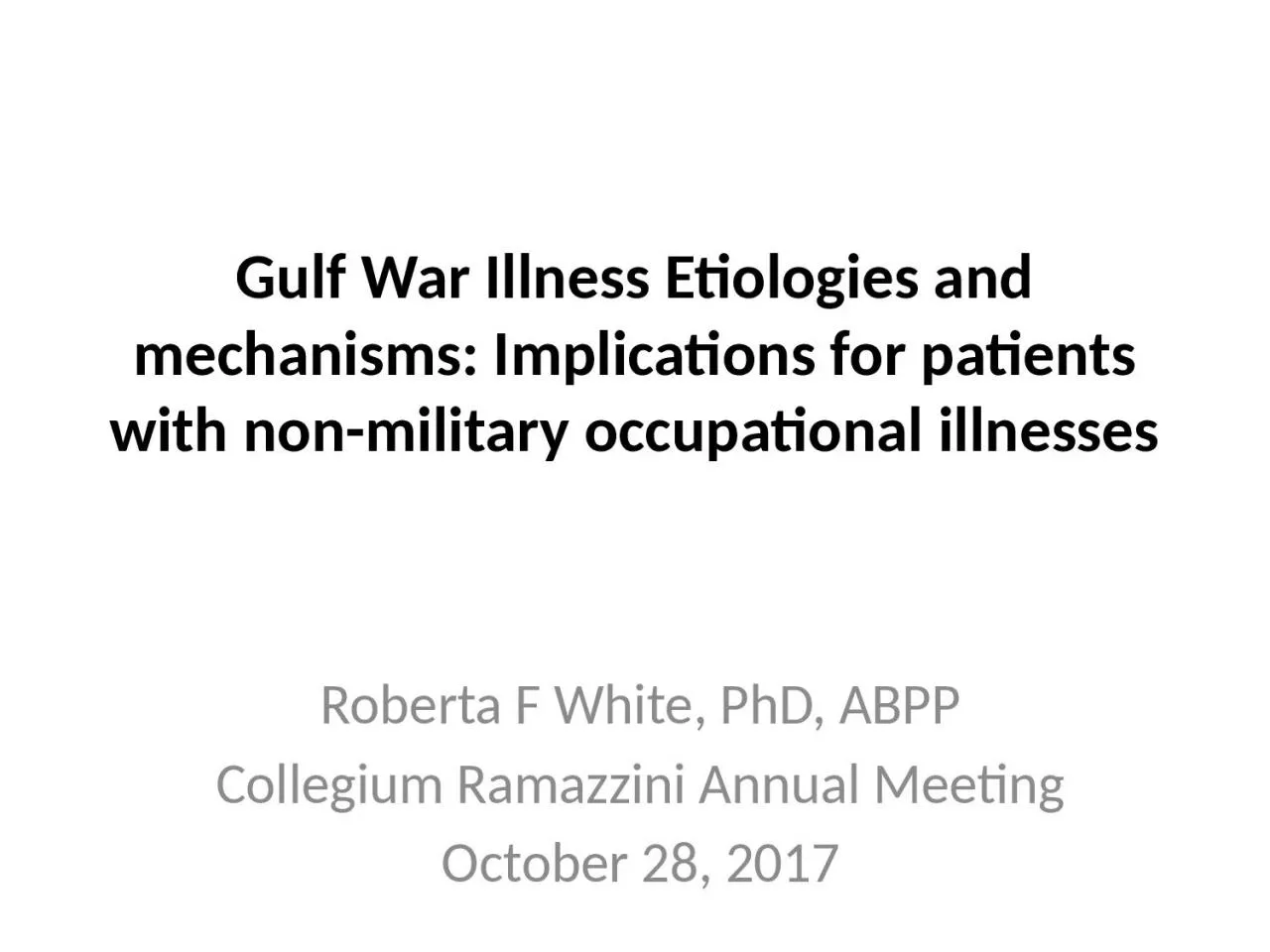

Roberta F White P hD ABPP Collegium Ramazzini Annual Meeting October 28 2017 19901991 Gulf War Operations Desert ShieldDesert Storm Aug 2 1990 Iraq invaded Kuwait Jan 16 1991 Air strikes began ID: 1036336
Download Presentation The PPT/PDF document "Gulf War Illness Etiologies and mechanis..." is the property of its rightful owner. Permission is granted to download and print the materials on this web site for personal, non-commercial use only, and to display it on your personal computer provided you do not modify the materials and that you retain all copyright notices contained in the materials. By downloading content from our website, you accept the terms of this agreement.
1. Gulf War Illness Etiologies and mechanisms: Implications for patients with non-military occupational illnesses Roberta F White, PhD, ABPPCollegium Ramazzini Annual MeetingOctober 28, 2017
2. 1990-1991 Gulf War: Operations Desert Shield/Desert StormAug 2, 1990 - Iraq invaded Kuwait Jan 16, 1991 - Air strikes beganFeb 24, 1991 - Ground combat beganFeb 28, 1991 - Cease fire declared________________- 6 weeks air strikes, 4 day ground war- 37 countries in Allied Coalition ~ 700,000 U.S. troops - Relatively few Allied casualties
3. 1990-1991 Gulf War
4. Gulf War Illness Case Definitions: Based on Symptoms in Multiple Domains that Affect Gulf War Veteransat Significantly Excess RatesNEUROLOGICALSYMPTOMS Memory ProblemsHeadachesDizzinessMood ChangesRESPIRATORYSYMPTOMS Persistent CoughWheezingGASTROINTESTINALSYMPTOMS DiarrheaNauseaSKIN PROBLEMS RashesOther ProblemsPAIN SYMPTOMSJoint PainMuscle PainFATIGUESYMPTOMS FatigueSleep ProblemsAt least 10 different approaches to case definition have been used; some studies use no case definition
5. Large number of Gulf War-related experiences and exposuresof potential concernCombat stressChemical weapons*Oil well firesMunitions containing depleted uranium Heavy use of insecticides/repellants*PB pills (pyridostigmine bromide)*VaccinesInfectious diseasesTent heatersParticulatesFuel exposuresSolvents, CARC paint
6. Early Research1991: Ft Devens SurveyFocus: PTSD, psychiatric symptoms, health symptoms (HS36, short version) (N about 2000)1993: VA OPH clinical funding (Boston)*Foci: PTSD, multiple chemical sensitivity, chronic fatigue syndrome, chemical exposures1994-1999: VA Environmental Hazards Centers, Haley syndrome studiesThree centersNew Jersey (CFS/MCS)Portland (case definition)Boston (high symptom reporters, exposure-outcome)*
7. What Gulf War illness isn’tEarly findings from Devens cohort that have been repeatedly confirmedGulf War illness is not:Multiple chemical sensitivityChronic fatigue syndromeFibromyalgiaPost-traumatic stress disorderPsychiatric disordersRates of these disorders 1-6% in Devens cohort, <10% in later cohorts
8. 2008 Report (2004-2008)
9. 2014 Report (2008-2013)
10. White RF et al. Recent Research on Gulf War illness and other health problems in veterans of the 1991 Gulf War: Effects of toxicant exposures during deployment (Massachusetts, USA). Cortex. 15 September 2015; DOI: 10.1016/j.cortex.2015.08.022
11. Etiologic Factors for Gulf War IllnessSummary of Epidemiologic Studies of Gulf War Veterans- Psychological stressEvidence indicates no association- Pyridostigmine bromide (PB)- PesticidesEvidence consistently indicates a significant association- Low-level nerve agentsSustained oil well smoke- Large number of vaccines- Combinations of exposuresAssociation cannot be ruled out; evidence is inconsistent or limited in important ways - Depleted uranium- Anthrax vaccine- Fuels, solvents- Sand, particulates- Other Unlikely to have caused Gulf War illness for the majority of affected veterans
12. What is Gulf War illness??(My opinion)GWI is an occupational disease caused by exposures to OP-like substances and pesticides in the 1991 Gulf War theater and characterized by chronic neuroimmune dysfunction affecting multiple body systems in genetically vulnerable individualsIt is a form of chronic intoxication.
13. Research Studies on Gulf War Illness Using Animal Models: Take Home Message from OP-like Exposure StudiesAs in ill veterans, multiple organ systems implicatedMultiple combined exposures consistent with in-theater exposures are implicatedCNS and Autonomic nervous system function/structure affectedNeuroendocrine and neuroimmune measures preferentially affected No defined pathobiological “mechanism” but neuroinflammatory/ mitochondrial dysfunction represent key possibilities now under more extensive investigation.Genomic and proteomic profiling underway to identify novel targets for therapeutic interventions
14. What physical changes in the body led to Gulf War illness?
15. Do repeated low-dose exposures to OPs cause neurotoxicity in humans: occupational researchWeight of evidence (19 of 24 studies) suggests that occupational exposures to OPs are associated with decrements in neurobehavioral functionReview of 24 studies indicate decrements in exposed vs. controls for scores in several functional domain outcomes: Motor Speed/Coordination (10 studies) Information Processing Speed (8 studies) Complex Visual Motor/Executive Function (12 studies) Attention/Short-term Memory (9 studies) Memory (6 studies) Rohlman et al., 2011, Neurotoxicology
16. Implications beyond Gulf War illnessOccupational populations with OP exposuresEnvironmental exposures MixturesComplex immunological/multi-system responses to exposuresGene-environment interactionsEffective treatments
17. TreatmentsImprove well-being, pain, energyTai Chi, yoga, acupunctureBrain stimulation, O2Treat oxidative stress, mitochondrial dysfunction, neuroimmune responsesCo-enzyme Q10Low-dose naltrexone/avoid opiodsReverse damage/cure??
18. Thanks for listening and for your thoughts!